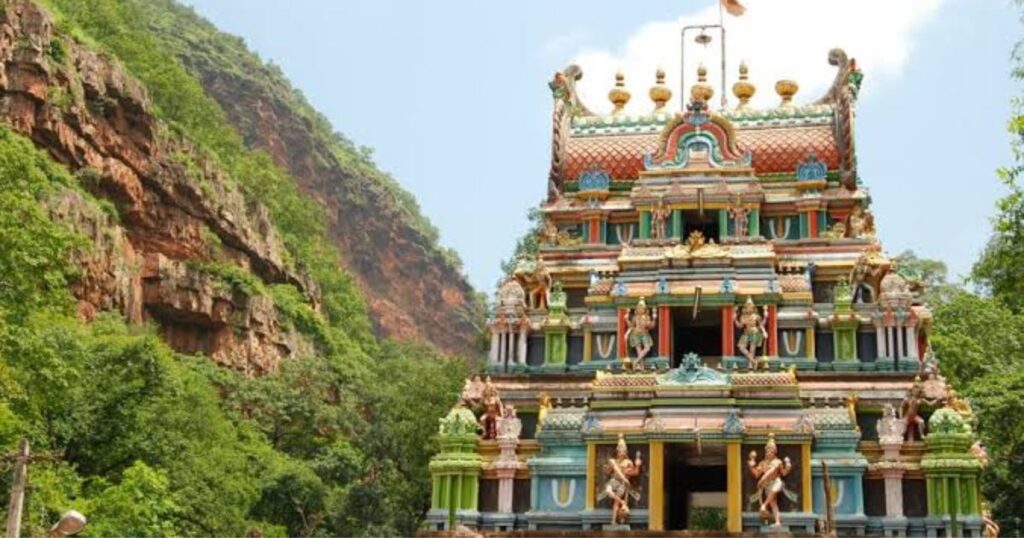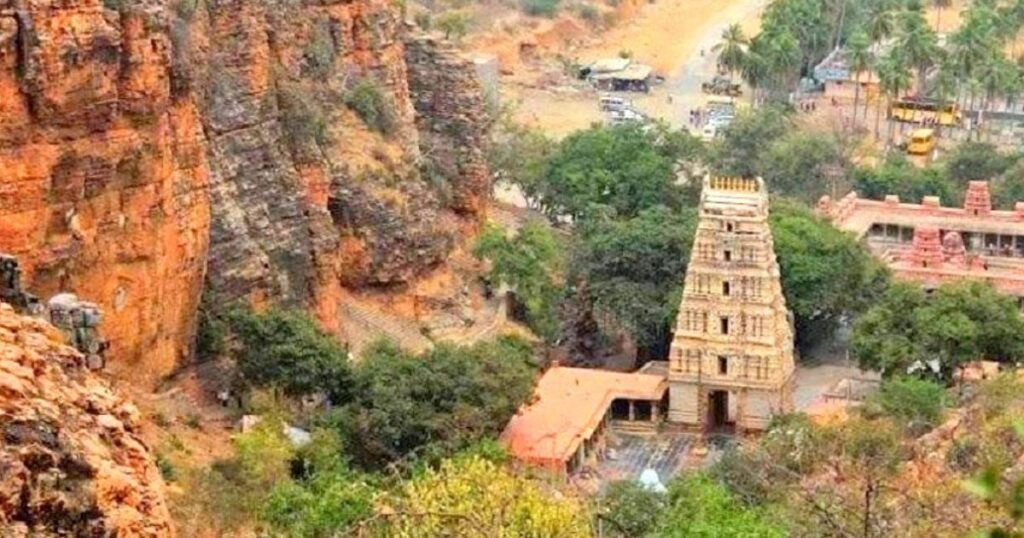Nestled in the Eastern Ghats of Andhra Pradesh, Ahobilam is a sacred pilgrimage site of profound significance in Hindu mythology. Known as the place where Lord Narasimha (the lion-man avatar of Lord Vishnu) defeated the demon king Hiranyakashipu, this mystical destination attracts devotees, history enthusiasts, and adventure seekers alike. Understanding the best time to visit Ahobilam is crucial for experiencing its divine aura and natural beauty to the fullest. Whether you're planning to climb the famous Ahobilam temple steps or embark on the challenging Ahobilam trek, timing your visit correctly will significantly enhance your experience.
Best Time to Visit Ahobilam : Quick Overview
Choosing the right time to visit Ahobilam can significantly enhance your pilgrimage or travel experience. The destination experiences distinct seasonal variations that affect accessibility, comfort, and the overall experience.
| Season | Months | Temperature | Crowd Level | Trek Difficulty | Temple Experience | Recommended |
| Winter | Nov-Feb | 15-25°C | High | Moderate | Excellent visibility, comfortable | ★★★★★ |
| Spring | Mar-May | 25-35°C | Moderate | Challenging | Good for early morning visits | ★★★☆☆ |
| Monsoon | Jun-Sep | 22-30°C | Low | Very Difficult | Limited access to some temples | ★★☆☆☆ |
| Autumn | Oct-Nov | 20-28°C | High (festivals) | Moderate | Festive atmosphere | ★★★★☆ |
You can also explore our affordable Pilgrimage tour package designed for Budget Travellers

Winter Season (November to February)
Winter stands out as the best time to visit Ahobilam for most travelers. During these pleasant months, the weather creates ideal conditions for both temple visits and treks to the Upper Ahobilam shrines. Key advantages include:
- Perfect temperatures ranging from 15-25°C, providing comfortable conditions for temple visits and treks
- Clear skies offering spectacular views of the Eastern Ghats landscape
- Dry terrain making the trek to Upper Ahobilam considerably safer and more accessible
- Enhanced visibility for appreciating the intricate temple architecture and sculptures
- Comfortable conditions for longer meditation or prayer sessions at the temples
The winter season also coincides with several important festivals at Ahobilam, including Vaikunta Ekadasi (December-January) and the Ahobilam Brahmotsavam (January-February), adding cultural richness to your visit. Many experienced travelers agree that November to February represents the absolute best time to visit Ahobilam for both spiritual and practical reasons.
Autumn Season (October to Early November)
- The autumn season serves as a transition period and brings its own unique charm to Ahobilam:
- Pleasant temperatures between 20-28°C with gradually decreasing humidity
- Lush green surroundings following the monsoon rains
- Important celebrations including Navaratri and occasional temple festivals
- Moderate crowd levels except during specific festival dates
- Rejuvenated waterfalls and streams along the trekking routes
Autumn offers a good balance between comfortable weather and natural beauty, with the added advantage of witnessing the temples amidst post-monsoon greenery. Many spiritual seekers from across India incorporate Ahobilam into their broader spiritual journeys across India, particularly during this season.
Summer Season (March to May)
Summer brings challenging conditions to Ahobilam but may suit certain travelers:
- Temperatures rising to 25-35°C, occasionally touching 40°C in May
- Significantly fewer visitors, allowing for more peaceful temple experiences
- Early morning (5:00-8:00 AM) and evening (4:00-7:00 PM) visits recommended
- Increased difficulty for treks due to heat and dehydration risks
- Special summer rituals and water offerings at certain shrines
If you plan a summer visit, carrying ample water, wearing appropriate sun protection, and planning temple visits during cooler hours becomes essential. The advantage of fewer crowds can make this season appealing for those seeking solitude in their spiritual journey.
Monsoon Season (June to September)
The monsoon season presents significant challenges for Ahobilam visitors:
- Heavy rainfall making trekking paths slippery and occasionally dangerous
- Limited accessibility to some of the Upper Ahobilam temples
- Risk of landslides in certain areas • Difficulty in crossing streams that separate some temples
- Lush, dramatic landscapes for those who brave the conditions
Despite these challenges, some adventure enthusiasts and photographers visit during early or late monsoon to witness the transformed landscape with flowing waterfalls and vibrant greenery. However, for regular pilgrims and tourists, this season is generally not recommended.
The Sacred Legacy of Ahobilam
Ahobilam, also called "Ahobalam" or "Singavelkunram" in Tamil, holds immense religious significance as one of the 108 Divya Desams (sacred abodes of Lord Vishnu). According to Hindu mythology, this is where Lord Vishnu took the fierce Narasimha avatar to protect his devotee Prahlada from his demonic father Hiranyakashipu.
The temple complex is divided into two sections: Lower Ahobilam (Diguva Ahobilam) and Upper Ahobilam (Eguva Ahobilam). Together, they house nine different forms of Lord Narasimha, collectively known as the Nava Narasimha temples. Each temple represents a different aspect of Lord Narasimha's incarnation and has its own unique architectural and spiritual significance.
Ahobilam Accommodation: Where to Stay
Accommodation options in Ahobilam are limited but adequate for pilgrims and travelers. Understanding the available options is essential, especially if you're visiting during the peak winter season (the best time to visit Ahobilam).
1. Temple Trust Guesthouses
- Location: Near Lower Ahobilam Temple
- Cost: ₹500-1500 per night depending on room type
- Facilities: Basic rooms, canteen, hot water (limited hours)
- Booking: Reserve through the temple office or official website
- Best for: Pilgrims seeking authentic spiritual experience
2. Government Tourism Accommodation
- Location: 1 km from Lower Ahobilam Temple
- Cost: ₹1200-2200 per night
- Facilities: Cleaner rooms, restaurant, better amenities
- Booking: Can be done online through APTDC website
- Best for: Tourists seeking more comfortable stay
3. Private Lodges and Guesthouses
- Cost: ₹500-1000 per night
- Facilities: Very basic, limited amenities
- Booking: Walk-in or phone reservation (unreliable)
- Best for: Budget travelers or during peak times when other options are full
Accommodation Tips
- Book at least 1-2 months in advance if visiting during festivals or winter season
- Carry your own toiletries and essentials as local shops have limited supplies •
- Power outages are common; carrying a flashlight is recommended
- Cellular connectivity is limited in the area
- Vegetarian-only food is available in most accommodations
For those seeking more comfortable accommodations, staying in nearby towns like Allagadda (50 km) or Nandyal (70 km) to have best time to visit ahobilam and a good experience.
Ahobilam Trek: The Spiritual Adventure
The trek to Upper Ahobilam is a central part of the pilgrimage experience, combining physical challenge with spiritual significance. This trek takes visitors through the dense forests of the Eastern Ghats to reach some of the most sacred Narasimha shrines.
Trek Details and Difficulty
- Water Sources: Limited availability; carrying your own water is essential
- Distance: Approximately 8 km round trip from Lower to Upper Ahobilam
- Elevation Gain: Around 800 meters
- Duration: 1.5–2 hours uphill; 1–1.5 hours downhill
- Difficulty Level: Moderate to challenging
- Terrain: Forest paths, rocky sections, and ancient stone steps
Best Seasons for Ahobilam Trek
Winter is generally the best time to visit Ahobilam, but here’s a seasonal breakdown for trekking:
- Autumn (Oct–Nov): Good trekking conditions with occasional rain showers
- Winter (Nov–Feb): Ideal trekking conditions with dry paths and pleasant temperatures
- Spring (Mar–May): Increasingly challenging due to heat; early morning starts are essential
- Monsoon (Jun–Sep): Not recommended because of slippery trails and flash flood risks
Spiritual Highlights Along the Trek
The trek itself is considered a form of moving meditation, with several points of spiritual significance:
- Prahlada Mettu: Where Lord Narasimha's devotee Prahlada is said to have meditated
- Jwala Narasimha Shrine: Located halfway up the trail, marking where the lord first appeared
- Ugra Stambham: The sacred pillar from which Lord Narasimha emerged
- Bhavanarayana Cave: A natural cave with ancient inscriptions
- Peaceful Forest Sections: Considered ideal for contemplation and chanting
Trekking Tips for Pilgrims
- Start early (preferably by 7 AM) to avoid afternoon heat
- Wear comfortable footwear with good grip
- Carry at least 2 liters of water per person
- Pack light snacks and lunch
- Respect the natural environment and sacred spaces
- Consider hiring a local guide for spiritual and historical insights
- Watch for wildlife including deer, various birds, and occasionally wild boars
Best Time to Visit Ahobilam : Temple Timing

Understanding the temple timings is crucial for organizing your itinerary, especially if you're making the journey during the peak pilgrim season.
Lower Ahobilam Main Temple Timings
The Lower Ahobilam Main Temple follows a structured schedule to accommodate daily rituals and devotees' visits. Timings are divided into morning, afternoon, and a special early darshan session that requires prior booking.
- Morning Session: 6:00 AM to 12:00 PM
- Afternoon Session: 4:00 PM to 8:00 PM
- Special Darshan: 5:00 AM to 6:00 AM (requires advance booking)
- Closed Period: 12:00 PM to 4:00 PM (temple cleaning and priest rest time)
Upper Ahobilam Temple Timings
The Upper Ahobilam Temple operates on a continuous schedule, allowing devotees to visit multiple shrines within its complex during the designated hours.
- Daily Opening Hours: 8:00 AM to 5:00 PM
- Note: No formal closing during mid-day, but priests may be available only at certain hours
- Special Considerations: During monsoon season, some Upper Ahobilam temples may close earlier (around 3:00 PM) due to safety concerns
Festival Timings
During major festivals, particularly Brahmotsavam (January-February), temple timings extend with:
- Special early morning rituals starting at 4:00 AM
- Evening processions until 10:00 PM
- Additional special darshans throughout the day
Practical Timing Tips
- Allow 3-4 hours for Lower Ahobilam temples
- Dedicate a full day (8-10 hours) for the Upper Ahobilam trek and temple visits
- Winter days (the best time to visit Ahobilam) provide about 11 hours of daylight, sufficient for comfortable exploration
- During summer, adjust your schedule for early morning and late afternoon visits, avoiding the intense midday heat
Nearest Railway Station to Ahobilam: Transportation Guide
Reaching Ahobilam requires planning as it's located in a relatively remote area. Understanding the transportation options helps ensure a smooth journey to this sacred destination.
Nandyal Railway Station
- Distance from Ahobilam: 70 km
- Connectivity: Well-connected to major cities including Hyderabad, Vijayawada, and Bangalore
- Trains: Several daily trains including Venkatadri Express, Krishna Express
- Last Mile: Taxis available from station to Ahobilam (₹1,200-1,500)
- Best Option For: Most travelers, especially those coming from Hyderabad
Cuddapah (Kadapa) Railway Station
- Distance from Ahobilam: 115 km
- Connectivity: Better connected to Chennai and southern cities
- Trains: Multiple daily connections including Rayalaseema Express
- Last Mile: Buses to Allagadda, then local transport to Ahobilam
- Best Option For: Travelers coming from Tamil Nadu
Kurnool Railway Station
- Distance from Ahobilam: 120 km
- Connectivity: Limited trains, mostly passenger trains
- Last Mile: Regular buses to Allagadda, then to Ahobilam
- Best Option For: Budget travelers with flexible time
Also you can check out our blog about the Places to Explore in Ajmer so that it can help you find the best place on your next trip.
Conclusion
The best time to visit Ahobilam is undoubtedly during the winter months from November to February when comfortable temperatures, clear skies, and dry conditions create perfect circumstances for both temple visits and the challenging trek to Upper Ahobilam. This season also coincides with important festivals that enhance the spiritual experience.
Whether you're drawn by religious devotion, historical interest, trekking adventure, or architectural appreciation, Ahobilam rewards visitors with profound experiences that connect the physical and spiritual realms. By understanding the temple steps, accommodation options, trekking conditions, temple timings, and transportation logistics outlined in this guide, you can ensure a fulfilling journey to this mystical destination.
Frenzy Holidays ensures a smooth and enriching travel experience from start to finish. You can visit us at Haware Centurion, S07/34, Nerul East, Sector 19A, Nerul, Navi Mumbai, Maharashtra 400706. For bookings or more information, call +91 7400453140, email [email protected], or visit www.frenzyholidays.com. So pack up and explore INDIA with frenzy holidays to have an unforgettable journey.
Best Time to Visit Ahobilam- FAQ's
What is the best time to visit Ahobilam?
The winter months from November to February are considered the best time to visit Ahobilam. During this period, temperatures range from 15-25°C, providing comfortable conditions for both temple visits and the trek to Upper Ahobilam.
How difficult is the trek from Lower Ahobilam to Upper Ahobilam?
The trek is considered moderate to challenging, involving approximately 1,200 stone steps and an 8 km round trip with an elevation gain of about 800 meters. It typically takes 1.5-2 hours uphill and 1-1.5 hours downhill for people with average fitness levels.
Where are the Nava Narasimha temples in Ahobilam and Best Time to Visit Ahobilam?
The Nava Narasimha temples are nine different shrines dedicated to various forms of Lord Narasimha scattered throughout Lower and Upper Ahobilam. Each temple represents a different aspect of Lord Narasimha's incarnation and has unique spiritual significance.
What accommodation options are available in Ahobilam?
Accommodation options include the Temple Trust Guesthouse (₹500-1500 per night), APTDC Government Tourism Hotel (₹1200-2200 per night), and private lodges (₹500-1000 per night). It's advisable to book 1-2 months in advance during peak season.
What is the nearest railway station to Ahobilam?
Nandyal Railway Station is the most convenient, located 70 km from Ahobilam. Other options include Cuddapah (Kadapa) Railway Station (115 km) and Kurnool Railway Station (120 km).
Is Ahobilam accessible during the monsoon season?
While Ahobilam is technically accessible during monsoon (June-September), it's not recommended due to slippery trekking paths, limited accessibility to some Upper Ahobilam temples, and risks of landslides. Some temples may close earlier during this season for safety reasons.
What is the Best Time to Visit Ahobilam temple?
Lower Ahobilam Main Temple: 6:00 AM to 12:00 PM and 4:00 PM to 8:00 PM
Upper Ahobilam Temples: 8:00 AM to 5:00 PM
During festivals, especially Brahmotsavam (January-February), timings extend for special rituals and processions.
What should I pack for visiting Ahobilam?
Essential items include comfortable footwear with good grip, sufficient water (at least 2 liters per person for the trek), sun protection, light snacks, a flashlight (due to common power outages), basic toiletries, and appropriate clothing for a temple visit.
Which important festivals are celebrated at Ahobilam?
The major festivals at Ahobilam include Ahobilam Brahmotsavam (January-February), Vaikunta Ekadasi (December-January), and Narasimha Jayanti. These festivals feature special rituals, processions, and cultural events that enhance the spiritual experience.
Can a day is sufficient to have Best Time to Visit Ahobilam?
While it's possible to visit Lower Ahobilam as a day trip from nearby towns like Allagadda (50 km) or Nandyal (70 km), experiencing both Lower and Upper Ahobilam properly requires at least one overnight stay. A two-day visit is ideal to fully appreciate all nine Narasimha temples and the surrounding natural beauty.

